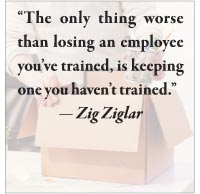The Best Laid Plans…
Sharon Koehler
Artistic Stone Design
 All companies, big and small, have turnover. People quit. People get fired or laid off. Some people get too sick to continue working, and some people retire. There are many reasons for turnover. Sometimes it’s the company’s fault. Sometimes it’s the worker’s fault, and sometimes it’s just circumstance. Whatever the reason, there is always turnover.
All companies, big and small, have turnover. People quit. People get fired or laid off. Some people get too sick to continue working, and some people retire. There are many reasons for turnover. Sometimes it’s the company’s fault. Sometimes it’s the worker’s fault, and sometimes it’s just circumstance. Whatever the reason, there is always turnover.
You can’t always plan for turnover. People can become ill suddenly, or in some cases an employee may commit an act so awful that it requires immediate termination. Sometimes employees quit with little to no notice, and occasionally they just stop showing up. However, whenever possible, try to plan for turnover.
A while back, my boss told me he needed a five-year notice if I ever planned to leave. Was he kidding? Probably, but as I progressed in the company, I realized that he would need to plan ahead for my retirement.
I would, as well. So in keeping with the plans that need to be made, I recently gave my 5-year notice. And SURPRISE… my boss very promptly went out and hired someone to replace me. Do I still have a job? Of course, I do. I’m loyal. He’s loyal. It’s all good, and I have 5 years to train my replacement. As strange as this all sounds, it is absolutely the right thing to do.
Companies need as much stability as possible to run smoothly and stay on track. If you have a worker that isn’t performing well and termination is going to be unavoidable, make a plan to replace that worker before termination. Go through the interview and hiring process to find a qualified candidate for the position. Settle on a start date with the new hire. That start date will also help with the termination date of the current employee. (Of course, be quiet about it. You certainly don’t want anyone finding out before it’s time.)
On the other hand, if you are going to lay an employee off for whatever reason and you don’t plan to replace them, you still need a plan. Never assume that one or more of their co-workers will step up and fill the void. They may not know everything that employee did, or they may not know how to do it. Sit down and decide who is going to do what to fill the hole created by the laid-off worker.
Don’t be surprised if someone asks for a raise with the added responsibility.
Be prepared, there may have to be some training involved. There also may be some resistance, especially if the laid off person was well liked.
Retirement is a different issue. The retiring employee will more than likely have a time frame, but their plan will probably be a bit flexible. I didn’t tell my boss I intended to retire on May 25, 2024. I just said I intend to retire in 5 years. Now, we all know there is no guarantee that I will be around for 5 more years. I could get hit by a bus; I could fall off a mountain or get bitten by a deadly snake. Who knows? You can’t plan for those things, but for routine business comings and goings, there should always be a plan.
It doesn’t matter if the employee leaving is an hourly helper on a truck or upper management. You need a plan for both, and every position in between. An hourly helper on a truck serves a purpose. They do a job and if you don’t have a plan in place you will more than likely have to take an employee from a different department, who does a different job, and throw them into a job they are not familiar with, and don’t know how to do. That hurts two different aspects of the business. It shorts the department you stole the worker from, and it frustrates the remaining truck crew (and probably the substitute worker) because they have to work around someone who doesn’t know what to do.
Upper management is usually replaced from a promotion “in house,” which means you need a plan to replace the promoted worker, as well.
Turnovers can be hard on a company but if you plan ahead, you may get a much smoother transition. You plan for financial issues. You should plan for weather and other disasters. Why not plan for people– your most valuable resource?
Please send your thoughts on this article to Sharon Koehler at Sharon@asdrva.rocks.